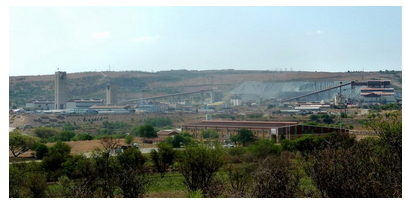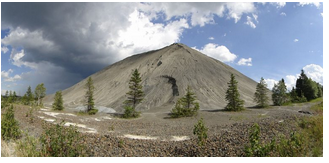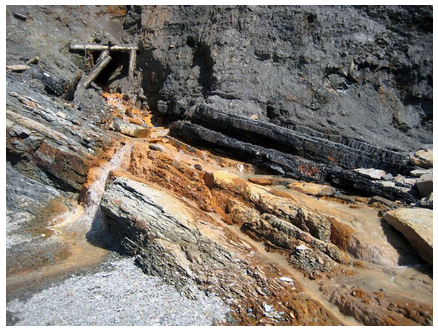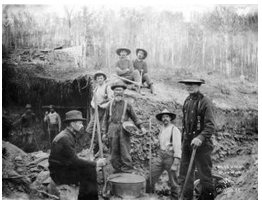9.1.3: Mineral Deposits, Ore Deposits, and Mining
- Page ID
- 18484
A mineral deposit is a place in Earth’s crust where geologic processes have concentrated one or more minerals at greater abundance than in the average crust. An ore deposit is a mineral deposit that can be produced to make a profit. Thus, all ore deposits are mineral deposits, but the reverse is not true.
Many factors control the profitability of an ore deposit. We call the amount of known ore in a deposit the reserves. The concentration of a commodity in the ore (the “richness” of the ore) determines the ore grade. When calculating the profitability, amount of reserves and ore grade are the most significant geological factors, although economic factors such as extraction costs, processing costs, and market price are often more decisive. A high-grade ore deposit may be uneconomical to mine if the reserves are low, because start-up costs could consume all profits. A large high-grade deposit may be uneconomical to mine if it is in a remote area. Even large, developed deposits can become uneconomical if the market price falls, perhaps due to the discovery of a better deposit somewhere else.

Mining operations have many guises. Surface mining involves uncovering resources by removing overburden. This is done in several ways but, for metal deposits, open pit mining is most common. The Bingham Canyon Mine (Figure 9.10, above), near Salt Lake City, is the world’s deepest open pit. It is 4.5 km by 1.3 km in area and is 1.2 km deep. Since mining began just over 100 years ago, the Bingham Canyon open-pit mine has produced 24 million tons of copper, 790 tons of gold, 6,600 tons of silver, and 425,000 tons of molybdenum. To put these numbers in perspective, consider that, in total, the people of the world consume about 30 million tons of newly mined copper, 2,750 tons of newly mined gold, 30,000 tons of newly mined silver, and 250,000 tons newly mined molybdenum every year. So, the cumulative amounts of copper, gold, silver and molybdenum mined from Bingham Canyon over an entire century are insufficient to satisfy peoples’ needs for even one year. Thus, to maintain our societies and lifestyles, without recycling metals, the world’s people need many mines like the one at Bingham Canyon.

When open pit mining cannot get to valuable resources, mining may move underground. Underground mining involves digging tunnels and shafts to reach buried ore bodies. This takes on many forms depending on the nature of an ore deposit. The Mponeng Gold Mine (Figure 9.11), southwest of Johannesburg, South Africa, is the deepest mine in the world. Its deepest workings are more than 3.5 km below Earth’s surface. Figure 9.11 shows the mine buildings on the surface; the tall towers are head frames where lifts descend to depth where the actual mining takes place.

After mining, processing separates and concentrates valuable minerals from the ore. This involves crushing the ore rock, followed by gravity and chemical separation. Any unwanted rock and minerals, called waste rock and gangue, respectively, are usually discarded in tailings piles. This photo (Figure 9.12) shows tailings at a mine just south of Quebec City, Quebec. Besides piling discarded material on the surface, sometimes miners return wastes to abandoned portions of a mine to fill voids left by ore removal.

Mining commonly comes with some significant environmental costs because disposal of mine waste can lead to significant problems. And, abandoned mines also pose environmental problems. Runoff from waste piles or mine sites may create soil, groundwater, or surface water contamination. Many ore bodies, for example, are rich in sulfide minerals. After mining ceases, sulfur from the minerals can react with water and air to create acid mine drainage (Figure 9.13) or acid runoff from tailings piles. The resulting sulfuric acid may kill vegetation and fish in nearby lakes and streams. Contamination may also occur because of non-natural chemicals used during mineral production. And, there may be terrain costs. After mining ceases it is often impossible to restore the mined land to anything like its pre-mining condition. Open pits remain forever and so do tailings piles. Mining sometimes also leads to increased erosion or the formation of sinkholes.

Most mining companies are responsible and do their best to reduce impacts while mining takes place, but eliminating them all is impossible. And, many mining companies do a good job of cleaning up after they are done. The photo seen in Figure 9.14 shows a site near Cannock Chase, England, that was once a coal mine. The area was restored and is now used for picnicking, walking and cycling. The United States, like many other countries, has enacted laws to limit the damage caused by mining. These laws, however, are often controversial because they may drive up the price of mined commodities. Communities that rely on mining for employment, in particular, worry that regulations may lead eventually to loss of jobs.
Mining, the Environment, and Politics

Mining, especially public land mining, is sometimes a controversial environmental issue. For example, the 1872 Mining Law gives U.S. citizens and corporations the right to stake claims and mine public lands if they can show that the mining is profitable. The claims last forever, provided miners invest $100 in the property each year. Claim holders have the right to purchase the surface and mineral rights at very low cost through a process called patenting, often at
1 billion worth of minerals from public lands without paying anything back to taxpayers. So, the 1872 law is a federal subsidy for mining.
Many environmental groups want to see Congress change the 1872 law. They argue that public lands are for the public, not mining corporations, and they point out that mining is incompatible with other uses such as wildlife habitat, hiking, and camping. Furthermore, mining leaves scars on the land and may cause long-term environmental degradation. According to a 1998 article in the journal Environmental Law, “there are over 550,000 abandoned hard-rock mines, most of which have been left for government-funded clean-up efforts at an estimated cost of
72 billion.”
The mining industry argues that we need the 1872 law to ensure a flow of mineral resources to our citizens. They point out the importance of mining to some local western economies and say they can mine in an environmentally friendly way. They also accuse many mining opponents of having a “NIMBY” (not in my backyard) mentality.
The mining industry is correct when they argue that we need mineral resources and they have to come from somewhere. Despite industry’s claims, however, mining always has a cost to the environment. A visit to active or abandoned mines confirms this. Besides scars on the land, less obvious problems include air, water, and soil pollution. All these problems can be limited, but not eliminated, by following the best mining practices.
In today’s industrial world we need mineral resources. The real questions are where are they going to come from and how much are we willing to pay? Those who seek reform of the 1872 law argue that some areas should be off limits to mining, that mining companies should pay more in royalties, and that there should be strict antipollution and land reclamation requirements. If enacted by Congress, these changes might affect the price of mineral commodities, but most economists think the effect would be very small.


